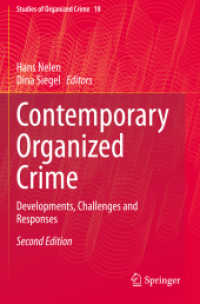Full Description
This book documents the state of the art in pediatric neurosurgery with the intention of providing a comprehensive guide to the management of the full range of pediatric neurosurgical disorders that will aid in the delivery of optimal care. Detailed practical instruction, taking into account recent advances, is provided on the neurosurgical treatment of congenital brain malformations, cerebrovascular diseases, head injuries and spinal trauma, infections, functional disorders, congenital and developmental spinal disorders, and brain and spinal tumors. Pearls and pitfalls are highlighted, and attention drawn to the most useful tips and tricks. Information is also included on relevant related topics, including the principles of neuroimaging, the physiological responses of newborns, infants, and children to neurosurgical trauma, preoperative evaluation, anesthesiology and intensive care, and other forms of therapy. The authors are renowned experts in the field, and the text is supportedby a wealth of high-quality images. Handbook of Pediatric Neurosurgery will be of value for neurosurgeons of all levels of experience, as well as for pediatricians, neuroradiologists, neuropathologists, and neuro-oncologists.
Contents
1.Generalities: Embryology of CNS.- Neurologic development and objective neurological examination of the infant and the child.- Principles of neuroimaging.- Neurologic development and objective neurological examination of the infant and the child.- Physiological responses of the newborn, infant and child to neurosurgical trauma.- Preoperative evaluation, anesthesiological and intensive care management.- Pediatric chemotherapy.- Pediatric radiotherapy.- 2. Congenital brain malformation and acquired disorders: Encephaloceles, meningoceles, dermal sinuses.- Chiari malformations (types II,III,IV) .- Craniopagus.- Physiology and abnormalities of CSF dynamics (including infantile benign hydrocephalus and benign intracranial hypertension) .- Hydrocephalus: Clinical presentation according to age and etiology.-Pathological changes induced by the hydrocephalus/ compensative changes.-Hydrocephalus: Neuroimaging.- Fetal hydrocephalus and its treatment inutero.-Posthemorrhagic hydrocephalus.-Postinfective hydrocephalus.- Multiloculated hydrocephalus.-Aqueductal stenosis and hydrcephalus.-X-linked, metabolic hydrocephalus.- Hydrocephalus associated to MM.- Hydrocephalus associated to tumors.- Medical treatment of hydrocephalus.- Surgical treatment of hydrocephalus based on CSF shunt devices.-In-depth view: Functional chracteristics of CSF shunt devices (pros and cons) .- In-depth view: How to perform a V-P CSF shunt.- In-depth view: How to perform a V-A CSF shunt.- In-depth view: How to perform a lumbo-peritoneal CSF shunt.- In-depth view: How to perform a pleural, glad bladder shunt.-In-depth view: How to perform a subgaleal shunt.- In-depth view: External CSF shunts.-Infective, mechanical and functional complications in the surgical treatment of hydrocephalus.- Late complications following surgical treatment of hydrocephalus.-Endoscopic treatment of hydrocephalus.-In-depth view: How to perform an endoscopic third-ventricle cisternostomy.- In-depth view: How to perform an endoscopic plexectomy.-Complications following endoscopic treatment of hydrocephalus.-Arachnoid cysts.-Dandy-Walker malformations/variants.- Cortical dysplasia.- Neurocutaneous syndromes.-Neurofibromatosis.-SturgeWeber.-Tuberous sclerosis.- HippelLindau.-Hemimegalencephaly.-Cerebrocutaneous melanosis.- .Encephalo cutaneous lipomatosis.- 3. Cerebrovascular diseases: Vein of Galen aneurysmal malformations.-Artero-venous malformations.-Venous angiomas and cavernomas.- Cerebral aneurysms.-Moya-moya disease.- 4. Congenital malformations of the skull and its coverings: Craniosynostoses: Management Issues and Evolution in concepts.- Craniosynostoses: Genetic base, genes, chromosomes and resulting syndromes.- Craniosynostoses: Lessons learned from animal models.- Sagittal synostoses.- Coronal (uni and bilateral) synostoses.-Metopic synostoses.- Lambdoid synostoses.-Non syndromic plurisutural synostoses (oxycephaly, Mercedes) .- Syndromic synostoses.-Secondary synostoses (Metabolic, Iatrogenic, osteopetrosis, etc) .- In-depth view: ICP in craniosynostosis.- In-depth view: Neuropsychological evaluation in craniosynostosis.-In-depth view: Psycho-Sociological repercussions of craniosynostosis.- In-depth view: Deformational plagiocephaly.- In-depth view: Management of craniosynostosis: Evaluation of results.- In-depth view: Blood sparing and anesthesiological issues in craniosynostosis.- In-depth view: Osteogenic distraction.-In-depth view: Endoscopy assisted techniques.- In-depth view: Spring assisted distraction.-In-depth view: Bone splitting and materials.-Scalp agenesis. .- 5. Head Injuries: Birth related head traumas.- Accidental head traumas.-Non-accidental head injuries.-Cranial decompression.- Outcomes, principles of rehabilitation.-6. Infections: Meningitis: neurosurgical implications.- .Encephalitis.- Empyemas and brain abscesses.-Parasitic infestations, fungal and TB.- 7. Neoplasms: Genetic basis and classification of cerebral neoplasms.- Familial syndromes.-Congenital and infantile tumors.-Cerebral gliomas.-Thalamic gliomas.-Optic pathways gliomas.- Pituitary adenomas.-Craniopharyngiomas and Rathke cysts.- Pineal region tumors.- Brainstem tumors.- Cerebellar astrocytomas.-Medulloblastomas.- Ependymomas.- Meningiomas.- Skull base tumors.-Skull tumors.- .-8. Functional disorders: Epilepsy: genetic forms and sporadic forms.-Medical intractable epilepsy: preoperative evaluation.-Catastrophic epilepsy and hemispherectomy.-Temporal lobe epilepsy surgery.- Extra-temporal epilepsy surgery.- Palliative surgical techniques (VNS, Callosotomy) .- Neuromodulation.- Spasticity.- Movement disorders.-9. Congenital and developmental spinal disorders: Genetic basis of neural tube defects.- Classification of spinal dysraphic malformations according to embryogenesis: Gastrulation defects and Split cord malformation.- Primary neurulation defects: 1 Open neural tube defects.- Primary neurulation defects : 2 Limited dorsal myeloschisi (LDM) .Dermoid and dermal sinus tracts.-Secondary neurulation defects -1: Thickened filum terminale; Retained medullary cord.-Secondary neurulation defects -2: Terminal myelocystocoele.-Mixed primary and secondary neurulation defects: spinal cord lipomas.- Antenatal management of spinal dysraphysm-1: Imaging and diagnosis of antenatal spinal and spinal cord malformations.-Antenatal management of spinal dysraphysm-2: Antenatal surgery of myelominingocoele.-Caudal agenesis and associated spinal cord malformations.-Spinal cord and vertebral arteriovenous malformation and fistula.-Intraspinal cysts including syringomyelia unrelated to Chiari Malformation.- Scoliosis and other congenital vertebral anomalies. 10. Craniovertebral Junction Anomalies: Embryology, classification, and surgical management of bony malformations of the craniovertebral junction.-Chiari I Malformation and associated syringomyelia.- Anterior surgical approaches to the craniovertebral junction and upper cervical spine. 11. Spine and spinal cord neoplasms: Intramedullary tumours.- Extramedullary tumours.- Vertebral tumours. 12. Spinal trauma: Spine and spinal cord injuries in children: General aspects including Pure ligamentous injuries in children.- Spinal cord injury without radiographic abnormality (SCIWORA) .- Atlantooccipital dislocation (AOD) in children.- Atlantoaxial rotatory fixation (AARF) in children.-Outcome and principles of spinal cord rehabilitation in children. 13. Infectious diseases of the spine: Tuberculosis of the spine.- Bacterial, fungal, and other non-tuberculous infections of the spine, including intraspinal abscesses.- Juvenile disc diseases of the spine including infectious and non-infectious acute discitis.- 14. Intraoperative Neurophysiology Monitoring: Intraoperative neurophysiology monitoring for surgery of the brain.- Intraoperative neurophysiology monitoring for surgery of the spine and spinal cord.








